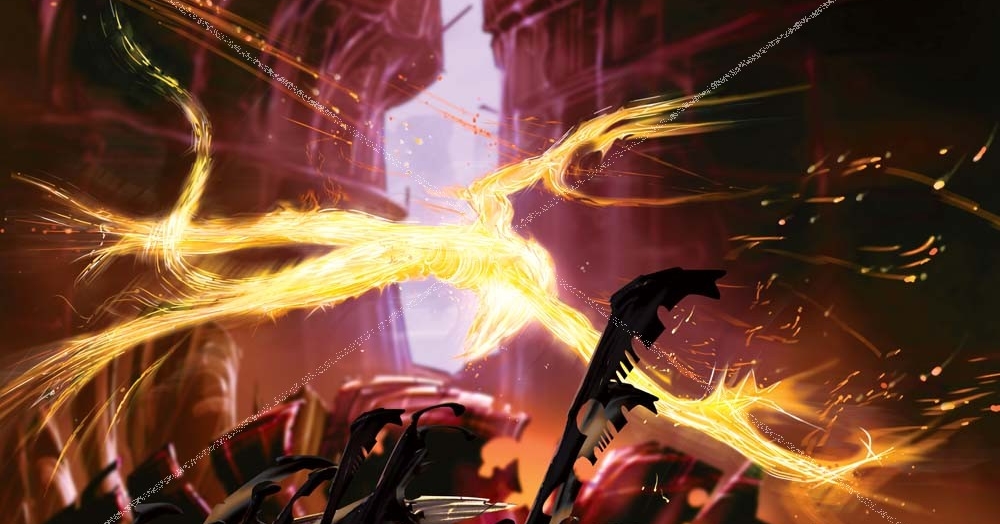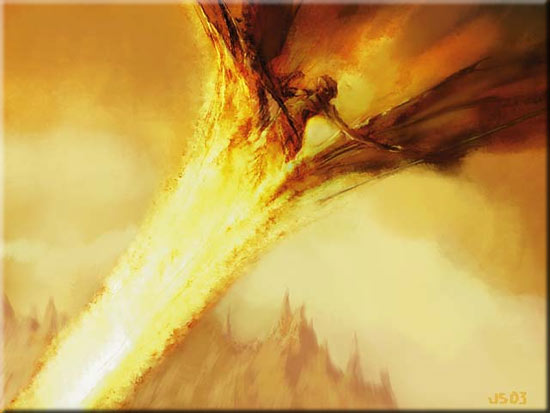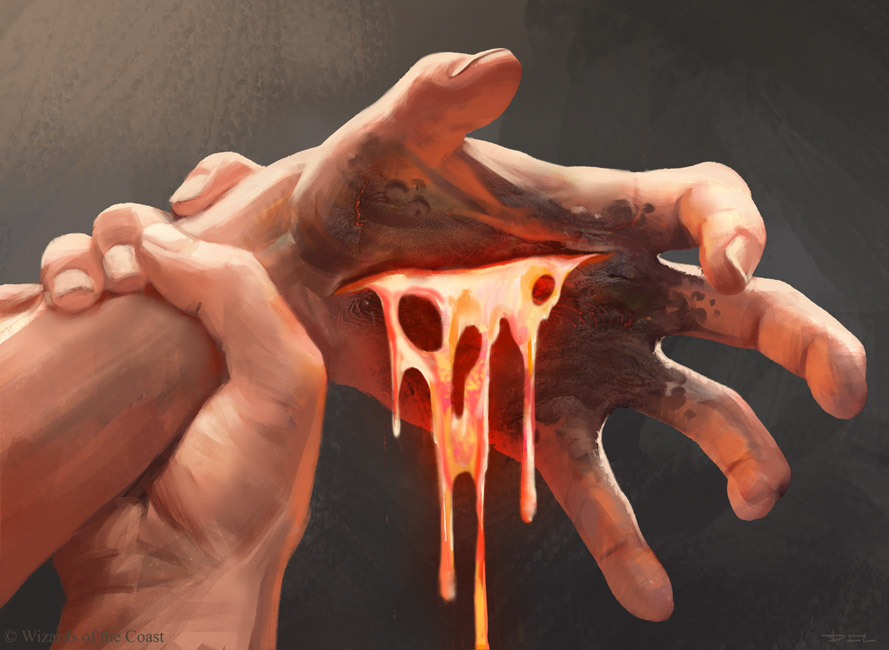Are you a Quiet Speculation member?
If not, now is a perfect time to join up! Our powerful tools, breaking-news analysis, and exclusive Discord channel will make sure you stay up to date and ahead of the curve.
Budget decks have a bad name, and somewhat deservedly so: most lists are based on top tier decks and sacrifice a lot of their power, preventing them from winning enough to be fun (if you're a spike, anyway).
Well, it doesn't have to be that way: Modern has a very large catalogue of cards, which facilitates some decks that require very few or no expensive cards but still pack a lot of punch thanks to unique advantages. Then there are some which require a fair amount of cards that cost about $5-10 each, rendering the final cost within about $200. Finally, we have top tier decks that are made expensive by just a few cards that aren't critical to the deck, and so can be cut, saving a lot of expense and only sacrificing a little power.
Burn falls into the third category. If you want to play one of the fastest, most powerful, and most consistent decks in the format, but don't want to drop $600 just yet, this article is for you.
[wp_ad_camp_1]
The List
First let's take a look at a typical winning Burn list. You're looking at $600 - $700 (paper) / $200 - $300 (MTGO) for this, based on TCGPlayer Mid and MTGOTraders prices.
Burn by pacoelflaco - Modern Daily #8068465, March 15, 2015, (4-0)
Ch-ch-changes
Most of Burn's cost comes from its fetches, so if we ditch those, we save about $400 off the bat. We're not going to splash because Boros doesn't have taplands like Blackcleave Cliffs to offer a semi-cheap, fast two-colour manabase in concert with more Retreats, and Gruul colours only offer a little boost in the form of Atarka's Command and Revelry at an added $40 (paper) cost. The cost is just a few dollars or less on MTGO, so feel free to make the obvious swaps if you're playing online.
Because of these changes to the stock Burn list, we have to replace several things.
First up, the Lavamancers (since they're not very good without fetches), and splash cards. The Lavamancers are mostly for Infect, plus they are a little slow and vulnerable sometimes in the wrong matchups, so we don't mind that much. For those we bring in 2 Spark Elemental. Elemental will make us more explosive but a little less consistent and versatile.
Boros Charm is a powerful card, but so is Magma Jet. Sure, it does half as much damage, but the Scry ensures you won't topdeck lands on those critical turns. We make a direct swap here, and in the process sacrifice raw power but gain some consistency.
Similarly, we take out all copies of Searing Blaze (also bad without fetches), and bring in the also great Searing Blood instead. There are pros and cons to each -- note Blood can't kill 3 toughness creatures, but a Gatherer search says there are zero commonly played 3 toughness creatures in Modern, so we don't consider that a con -- but Blaze is the slightly better card overall as it's easier to trigger (especially these days, with all the fatties running about). So, we sacrifice a little consistency, but gain a little versatility in exchange (as Blood can kill 2 toughness creatures, of which there are quite a few, more often).
Helix will be replaced with 2 Skullcrack (and the 2 Skullcrack in the board will disappear). Many Burn lists run 4 of them main anyway. In doing so, we exchange game versus aggro for added lifegain hate. We'll also bring in a another Spark Elemental, which provides further explosiveness, and helps to make up for the next card we cut...
Revelry can become Smash to Smithereens. This makes our Burn list more vulnerable to Leyline of Sanctity, unfortunately.
Skullcracks are replaced by Pyrite Spellbomb, which fights enemy Firewalkers. We don't lose anything in doing so, because we've moved them mainboard.
Palms are now Forked Bolt. This hurts the Auras matchup (not common), but still helps against Infect and Affinity (very common). You could also use Pithing Needle here, which can't damage players, but can't be dodged by pump. If your meta is heavy on Auras, swap Bolt or something else for Aura Barbs.
Kor Firewalker can become Dragon's Claw, which performs the same role (Burn hate) but is vulnerable to artifact destruction and doesn't bring a body. However, Burn probably won't side in their Revelries against you, at least not for one of your games (if you go to three).
Path becomes Molten Rain. This hurts any matchup with fatties, namely Siege Rhino and Wurmcoil Engine, but we become stronger against Tron and Amulet.
Helix and Moon swap for Searing Blood and a Relic of Progenitus, hurting us a bit in the aggro matchups and making Abzan, Tron, and Amulet harder (thankfully Blood is also good against aggro, and Molten Rain alleviates the latter two situations), in favor of more creature control and graveyard hate (useful with all the Delve about).
Burn Revised
That all brings us to a tight list that runs about $180 (paper) / $100 (MTGO).
Budget Burn by Sean Ridgeley - March 17, 2015
If that's still not cheap enough of a Burn list for you, you can replace the Goblin Guide and Eidolon, to bring you the list below. This will bring the price down to about $90 (paper) / $20 (MTGO), though the deck will suffer quite a bit more for it (they are some of your strongest cards, particularly against Leyline).
Extreme Budget Burn by Sean Ridgeley - March 17, 2015
Upgrading
Assuming you're a competitive player on a budget, eventually you'll want to upgrade your budget Burn list to the real deal, either bit by bit, or all at once.
If you go with the $180 / $100 list, grab the fetches, shocks, and Searing Blaze first ($400), then the splash cards ($40 / $30), then the Lavamancers ($10 / $7), then the Blood Moon ($25 / $20).
If you go with the $80 / $25 list, buy the Goblin Guides ($80 / $25), then the Eidolons ($30 / $60), then fetches, then splash cards, and finally, Lavamancers.








Would it be at all viable to still go with the white splash using shock and pain lands? With 20 lands and 8 of them bearing white it could be feasible while not budget breaking and since burn is looking to win in so few turns to begin with having to risk pinging yourself for those lands is not as big of a deal.
If you have the cards already, I might recommend it (that is a lot of damage to be taking, though, even for Burn, and it’s less consistent), but if you don’t, you’re better off just saving up for fetches, particularly with BFZ coming out. Budget is all about getting the most power for the least amount of money — the amount of power you get with that for the cost required doesn’t scale well.
I suppose I have not looked into the price tag on shocks lately since I already have them. I like the idea of throwing together a budget burn deck to use for a week or two just for a change of pace, but hate to give up the white splash.
Try it out. Could be good.
Any chance of “Playing XX on a Budget” being a semi-regular feature?
There is approximately a 100% chance. The more popular it proves, the longer I will continue it.
A green splash is much easier on the wallet with copperline gorges, karplusan forest, and stomping grounds.
Also gives you access to Atarka’s Command.
And sideboard revelry and literally nothing else.
I like this budget list because it can be improved incrementally, there is a clear path from the budget list to the full list and the deck will gradually function better. Perfect for people who are on some $x/month budget. I guess that’s a big reason why Burn is so popular on MTGO.
Sometimes budget articles decide that the deck’s _entire game plan_ needs to be changed when important cards are missing. That’s less interesting to me, because that doesn’t yield something that can slowly be upgraded towards the full list over time.
But of course, often you have to — say, Scapeshift without Scapeshift is never going to have a similar game plan.
I have heard that there are many decks that share a number staples in the UWR colors, say Delver, Geist, Twin, UWR control. I haven’t checked in detail how far that is actually true. But it could be interesting to see how feasible it is to start from some cheap version of one of those decks and to build towards an expensive one, keeping functioning decks along the way.
Yep, that’s the idea. Glad you like it.
I think an article about investing in certain decks (like the ones you mentioned, among others) as a means to save money long-term due to the shared staples could make for a very useful article. I’ll pocket that idea. Thanks!
How do you get around Leyline of Sanctity on the Extreme Budget version aside from creature combat?